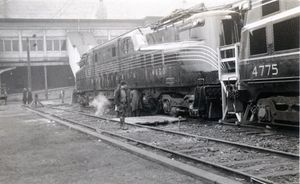ASME-Landmark:Penn. RR GG1 Electric Locomotive
In 1913, the Pennsylvania Railroad decided to electrify its tracks in the vicinity of Philadelphia. The system, at 11,000 volts and 25 hertz, expanded until, by the early 1930s, it stretched from New York City south to Wilmington, Delaware, and west to Paoli, Pennsylvania. With the growth of the electrification came the need for more electric locomotives.
The GG1, designed in 1934, required two frames, each nearly forty feet long, which held three driver axle assemblies and a two-axle pilot truck. Driver axles fit into roller bearing boxes that could move vertically in pedestal jaws in the frame. Although none of these features were unique to the GG1, they were combined into a design that resulted in one of the best riding locomotives ever built, with firm stability at high speed and light wear to the track.
Two cabs for the crew were located in the middle of the body. These allowed the GG1 to be run in either direction without the time-consuming turning operation required by a steam locomotive. The cabs' central location protected the crew in case of a collision. This was the first time a Pennsylvania Railroad electric was initially designed with this crew safety feature. An oil-fired steam boiler for train heat provided 4,500 pounds of steam per hour.
The 4,620-horsepower GG1 was primarily a passenger locomotive, routinely operating at over 100 miles per hour, but was used in freight service as well. No. 4800 logged nearly 5 million miles in its forty-five-year life; it is now on display at the Railroad Museum of Pennsylvania. See ASME website for more information
